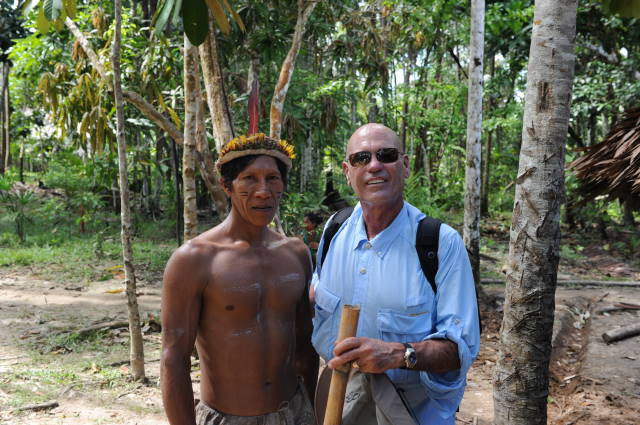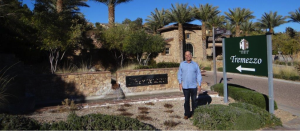Good afternoon dear readers and welcome back to Green Global! This is Ken Baxter of Las Vegas and today is Wednesday, August 12th, 2015. What a beautiful day it is here in the valley. After spending the morning cooped up in a classroom finishing up some continuing education courses, it sure is nice to step outside and enjoy the fresh air!
Speaking of fresh air, have you ever wondered where our oxygen comes from? It is interesting to know that our atmosphere consists of approximately 78% nitrogen and 21% oxygen, with trace amounts of other gases. About 98% of atmospheric oxygen is made via photosynthesis – the process by which plants produce sugars from carbon dioxide and water, using the energy of the sun. Many vital oxygen sources can be found throughout the world – from the tiniest phytoplankton in the sea to the tallest trees in the forest; the Earth relies on a healthy, thriving, yet delicate oxygen-filled ecosystem to sustain life as we know it. Since the gas is primarily used up by all the living, breathing life forms on the planet, it must be constantly replenished.
After countless studies, scientists have ascertained that oxygen levels here on Earth have been relatively stable for several hundred million years, indicating that the consumption of this precious gas has been mostly balanced by the constant re-production through photosynthesis. But what happens when the natural process of our Earth’s life-sustaining oxygen replacement is inhibited? The answer is hidden in plain sight.
Within the last few decades, a noticeable decline in oxygen levels has been recorded on our planet. Even though oxygen itself is not a heat-trapping greenhouse gas, its concentration in our atmosphere can affect how much sunlight reaches the ground. You see, as oxygen levels are lowered and the air thins, more sunlight reaches the surface of the Earth. Since more moisture is then evaporated from the ground, it causes an increase in humidity levels. The humid water vapor (a greenhouse gas) causes more heat to be trapped at the Earth’s surface and temperatures begin to rise.
All over the world, human action is causing this “Climate Change” to happen right now. Due to excessive carbon dioxide emissions from the burning of fossil fuels, increased use of vehicles and airplanes for transportation, and widespread use of aerosols; as well as an elevated level of other greenhouse gases like methane, halocarbon, and nitrous oxide caused by agriculture and meat farming, landfills, fertilizers, and refrigerants; our growing carbon footprint is causing too much heat to be trapped at the surface of the Earth as well as eating away at the ozone layer, allowing increasingly dangerous levels of radiation to reach the troposphere we call home.
Another significant cause for global warming is the rampant rate of deforestation, or forest clearing, happening all over the world. Currently, it is estimated that deforestation is responsible for about 15% of all human-caused greenhouse gas emissions. In fact, one of our planet’s most indispensable ecosystems is suffering from deforestation right now. If you’ve visited our website, www.GreenGlobal.org, you’ll know that my lovely wife Linda and I started our Green Global public charity in response to learning about the devastating effects of deforestation on the Amazon rainforest.
The life force and namesake of this precious ecosystem is the Amazon River. Beginning in the Peruvian Andes, the Amazon winds its way east over the northern half of South America and meets the Atlantic Ocean in Belem, Brazil. Nearly 16% of the world’s river water flows through the 4,080 mile Amazon. With twenty eight billion gallons of water flowing into the Atlantic every minute from this massive river, the salinity of the ocean is diluted for more than 100 miles offshore. Recently, on our Amazon expedition, we traveled 2500 miles of the Amazon River and ended our journey in Belem, where we chartered a plane and viewed firsthand the devastating effects of clear cutting the Amazon rainforest.
Located in South America and covering over 2 million square miles, Amazonia – known to many as the “Lungs of Our Planet” – is primarily contained within Brazil, Peru, and Columbia. The Amazon rainforest is the world’s largest tropical rainforest and produces around 20% of the world’s oxygen. Scientists believe it contains no less than half of Earth’s species – 40,000 plant species, over 500 types of mammals, one-third of the world’s bird population, 175 kinds of lizards, 300 other reptile breeds, more species of fish than in the entire Atlantic Ocean, and an estimated 30 million insect varieties are native to the Amazon.
Unfortunately, more than 20% of this treasured forest has already been permanently destroyed. The abundantly rich rainforest environment also happens to be a highly prized resource for cattle farmers, loggers, mining operators, and subsistence farmers. Some of the forest has even been burned to make charcoal to power industrial plants. Sadly, it has been estimated that at the current rate of destruction, this irreplaceable treasure could be completely wiped out in less than thirty years. With less and less rainforest to produce our precious oxygen and absorb the large amounts of carbon dioxide we create, we are headed for a grim future without natural, nutrient-rich wonders such as the Amazon.
Since the 1970’s, cattle ranching has been the leading cause of deforestation in the vicinity. An estimated 70% of deforestation in the Amazon basin can be attributed to the devastating effects of cattle rearing, resulting in a loss of an area larger than the state of Washington. A recent Newsweek article informs us that that the rate of deforestation for cattle pasture has more than doubled in the last six months despite increased intervention from local environmental watchdogs like IBAMA.
Since Brazil is the world’s largest exporter of beef, with a commercial cattle head of approximately 190 million head of cattle, it is no wonder cattle farmers have resorted to forest cutting to make way for more grazing land. In fact, the Brazilian government offers billions of dollars in loans to support the expansion of its beef industry… and demand is growing daily.
Countries like Asia and Russia are the chief importers of Brazilian beef. It is expected that by 2018, beef exportation from Brazil will increase 93%, thereby increasing Brazil’s market share of world beef exports to an astounding 61%. Beef is the most carbon-intensive form of meat production on the planet, contributing more greenhouse gases to our planet than the entire transportation industry.
The production of beef for urban markets and the export of leather and other cattle products isn’t the only reason for converting rainforest into artificial grassland though. In a region where land prices are appreciating quickly, cattle farming is used as a vehicle for land speculation – much of which is illegal. Forestland has little value left untouched; however cleared land can also be sold to large scale farmers to plant valuable, yet destructive, soy crops.
Runoff from soy plantations carry substantial levels of agrochemicals, suspended soil, and organic matter – a major source of freshwater and groundwater contamination which can have serious detrimental impact on the health of people and wildlife in the area. Our unhealthy reliance on soy and soy byproducts are now a leading cause of deforestation throughout the world and especially in the Amazon. While it may not seem like we consume enough soy to have an impact, you’d be surprised to know that 80% of the world’s soybean crop is fed to livestock, so just about every bit of meat, cheese, eggs, or milk we consume has some form of soy in it.
Predatory logging also plays a central role in the destruction of the Amazon. Between 60-80% of all logging in the area is considered to be illegal. With the depletion of forests in Southeast Asia and Central Africa, the Amazon is being targeted as a key source for tropical timber. Huge, majestic trees like the Samauma, better known as the “Queen of the Forest”, are being exploited to make cheap plywood for American, Japanese, and European builders.
Working in remote forest areas, the loggers often use false permits, ignore any legal permit limitations, cut down protected tree species, and steal timber from protected areas and indigenous lands. Sadly, due to the remote locations of these logging sites, the weak presence of federal authorities, and a complex chain of operators involved in the cutting, hauling, and transportation of the cut logs; many of these illegal operations go undetected until it’s already too late. With only one federal inspector assigned to a four million hectare region (an area the size of Switzerland) to prevent these practices, it is no wonder illegal logging has carried on at such an alarming rate.
While it may not cause deforestation on the same scale as logging or mass agriculture production, mining for metals and mineral assets has also negatively affected the local environment. The Amazon is considered to have great potential for copper, tin, nickel, bauxite, manganese, iron ore, and especially gold. As a result, the governments in these Amazonian states are providing tax incentives for large-scale mining projects in order to boost their economies and development. Unfortunately, several hazardous yet unavoidable side effects also result from this lucrative practice.
Mining impacts the area’s water drainage, polluting water with run-off from the mines and threatening local communities and indigenous people with contaminated water and food supplies. Dangerous byproducts and chemicals are often emitted during the extraction of precious metals. The gold mining process, for example, causes large amounts of mercury to be excreted into the atmosphere and in the water. Rural villagers relying on locally caught fish for sustenance are in constant danger of mercury poisoning due to the release of this dangerous pollutant into the water supply.
The less widespread but still detrimental practice of Subsistence Agriculture, commonly referred to as “Slash and Burn” farming, is also threatening the health of the Amazon. This process of cutting down vegetation on a particular plot of land, setting fire to the remaining foliage, and using the ashes to provide nutrients to the soil for planting food crops has been employed by native and tribal people in regions like the Amazon for thousands of years. When done properly, slash and burn farming provides local communities with a source of food and income, yet critics claim that it contributes to a number of recurring problems specific to the environment. Deforestation, soil erosion, nutrient loss and desertification, and a reduction in biodiversity in the area are commonly attributed to the irresponsible use of subsistence agriculture.
Despite the constant threat of permanent deforestation, there are some things we, as world citizens, can do to help stop the rate of destruction and save what’s left of the Amazon rainforest. Some suggestions from the Rainforest Foundation include: avoiding all forms of palm oil (commonly used to make food and beauty products), giving a monetary gift to a charitable organization dedicated to preserving the region, lessening our consumption of meat products (especially beef), educating our children and peers about the devastating effects of deforestation and carbon pollution, choosing furniture made from non-threatened wood species, decreasing our consumption of fossil fuels for energy production, and especially reducing our dependence on carbon generating transportation.
On a grander scale, we must also hold corporations accountable for their socially and environmentally destructive business practices. Companies need to know that sourcing exotic lumber from trees found in the Amazon is non-sustainable and devastating to the rainforest ecosystem and to the world. Buying rainforest beef (typically sold to fast-food chains) contributes to increased demand for it and also leads to increased deforestation to provide more grazing land. By making large businesses aware of their actions through product boycotting and even public demonstration, significant headway can be made in forcing these companies to change their devious ways.
In addition, government action is also required to make a lasting impact on our environmental health. In Brazil and Peru, local governments and police agencies are still rife with corruption. Gangs and other criminal affiliates continue to be a major threat to the rainforest, and control much of the illegal logging activities in the innermost, hidden sanctuaries under cover of the dense canopies. Guilty of more than just illegal logging; these organizations are also responsible for invading public land, theft, committing environmental crimes, forgery, conspiracy, tax evasion, and money laundering. By petitioning federal governments, supporting local watchdog organizations, and even joining grass roots political organizations we can influence lobbyists and politicians to join and even lead our cause and help save the world’s precious rainforests from these criminals who seek to destroy one of the world’s most precious resources.
Recently, one of the world’s foremost conservationists, Dr. Claude Martin, the former head of the World Wildlife Fund, called the health of the world’s tropical forests “precarious”. Here at Green Global, we know something must be done now to stop the deforestation of the Amazon and the world’s other remaining rainforests. We urge you to remember that the most important aspects in fighting for environmental change are: doing something small is better than doing nothing at all and that even one person can make a big difference. So even if you only give up one kind of meat, make one charitable contribution, or drive to work two days instead of five, you can still make an impact. Furthermore, if we all do just one thing, no matter how insignificant it may seem, those small changes can add up to a huge movement when everyone contributes!
I hope you will join us in our mission to save the “Lungs of Our Planet”. For more information about our campaign to save the Amazon rainforest from deforestation, please visit our website: www.GreenGlobal.org. Here you’ll find valuable news articles, personal stories, and other useful environmental info including tips on how you can personally reduce your carbon footprint! You can also follow us on Twitter: @GreenGlobalOrb and “Like” us on Facebook: https://www.facebook.com/greenglobalorb to stay informed about the latest news on climate change reform, water conservation, and a host of other critical environmental causes.



